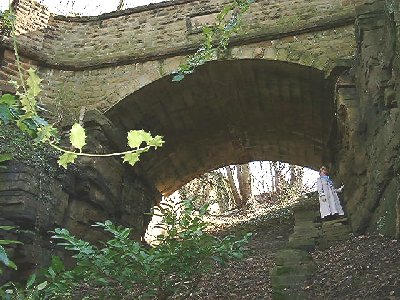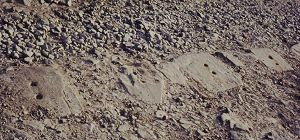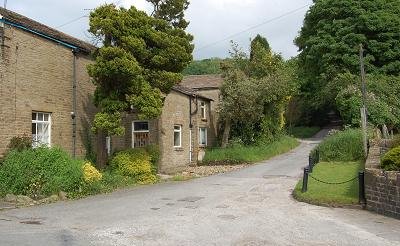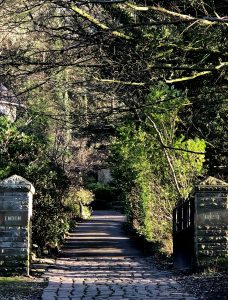The term Rally Road is a local corruption of Rail Road or, as we would normally call it today, a tramway. This was constructed by William Clayton in the mid 1830s from Bridge Quarry, high on the west side of Kerridge Hill, down to the then recently built Macclesfield Canal (1831), where the dry dock and wharf are today.
While the route of the entire tramway is easily seen today, there is not a single artefact remaining visible. It is also regrettable that we have never seen a picture of the tramway in operation. However, we can still deduce plenty about its layout and operation from the 1871 OS 25 inch map. A very short section of track was discovered under the grass near the dock and from this it was determined that the gauge was 3ft 6ins (just over 1 metre) and that the rails were in wrought iron. See the page on Kerridge Wharf and Stone Saw Mill.
 |
The first 90 metres or so of track was laid in the mouth (gank) of what was then known as Victoria quarry. From just above Windmill Lane the next 90 metres is very steep, an incline, and wagons were lifted and lowered on a cable or rope. A steam engine was located at the top with a large winding drum to hold the cable. Victoria Bridge (left), on Windmill Lane, was built to carry the road over the tramway incline and carries a date stone for May 24th 1837. There were two sets of tracks, one for loaded wagons being lowered, the other for empty wagons rising and providing some counterbalance to the descending wagons. The plaque on the front of the bridge is engraved May XXIV, MDCCCXXXVII which is date of the birthday and year of accession of Queen Victoria – May 24, 1837 |

|
The view on the left from 2018 is taken from under the bridge and looking down the incline. |
 Bollington Civic Society collection |
The two tracks would have continued down what is today the driveway to Endon Hall and Endon House. The slope here is much less than the incline and horses would have been used to hold back the loaded wagons and draw up the empties. Just before crossing Oak Lane the two tracks became one for the journey to the canal. Once the line crossed Oak Lane the gradient became easier all the way to the canal. The picture (from Bollington Civic Society’s collection, which can be seen at the Discovery Centre ) shows the Rally Road where it crosses Oak Lane – the war memorial stands on the right of the scene today (lower picture). The little girl is bowling her hoop along the road with a short stick, a very popular toy around 1910. Note the absence of rails at that date. |


I recall seeing, in the late 1970s, the last of the stone blocks on which the rails were laid, close to the entrance to Endon Hall. The picture shows a short row of these blocks, each with two holes into which the wooden pegs would be driven in order to hold the rails down. There would be another parallel row 3ft 6ins away for the other rail. However, these have disappeared under road making materials. An example of the track has been unearthed at Kerridge Wharf (dry dock) and it was very similar to that which can be seen today at Bugsworth basins![]() , at Buxworth near Whaley Bridge. This was laid out in the late 1790s, while the Clayton track would have been laid around 1836. The Rally Road is known to have been out of use by about 1870.
, at Buxworth near Whaley Bridge. This was laid out in the late 1790s, while the Clayton track would have been laid around 1836. The Rally Road is known to have been out of use by about 1870.
The tramway at Endon was more extensive than just the line from Victoria quarry to the canal. There were tracks along Windmill Lane serving other quarries. There was also a branch off at the bottom of the incline leading into the fields and on to serving a mine at Swanscoe.
The top end of the Rally Road in December 2019 as it passes Endon House. Incidentally the `Rally Road` had become Crown property in the 1950s on the closure of Wettonʼs Quarries. The former owners of Endon House were able to buy it from the Treasury Solicitors in the 1980ʼs. Most of the road is built on tipped quarry waste, known locally as scrapplings.
AcknowledgementsMy thanks go to those who researched and discovered the history that is presented in these pages. Please read the full acknowledgement of their remarkable achievement. Your Historic DocumentsPlease don’t chuck out those historic documents and pictures! Find out why here. |
